
Van Gogh Museum, Amsterdam
1 March – 1 September 2024
by BETH WILLIAMSON
Nothing quite prepares you for the vibrancy of the paintings by artist Matthew Wong (1984-2019). Even up against the best of work by Vincent van Gogh (1853-90), one of many artists in whom he found inspiration, Wong’s work glows and shimmers with a depth and vitality of colour that has no clear comparators. And therein lies the rub with Wong. There is no single comparator, not even Van Gogh. Yet, it was Van Gogh that the Chinese-Canadian artist felt an affinity to, artistically and personally, and that affinity is at the heart of this exhibition. In 2018, Wong said: “I see myself in him. The impossibility of belonging in this world.”1 Wong recognised Van Gogh’s struggles in himself, trying to carve out an artistic career while dealing with the mental turmoil of depression and other difficulties (Wong was autistic and had anxiety and Tourette’s syndrome). Both artists were self-taught and, coincidentally, painted their first picture aged 27. Tragically, both also died at a young age.
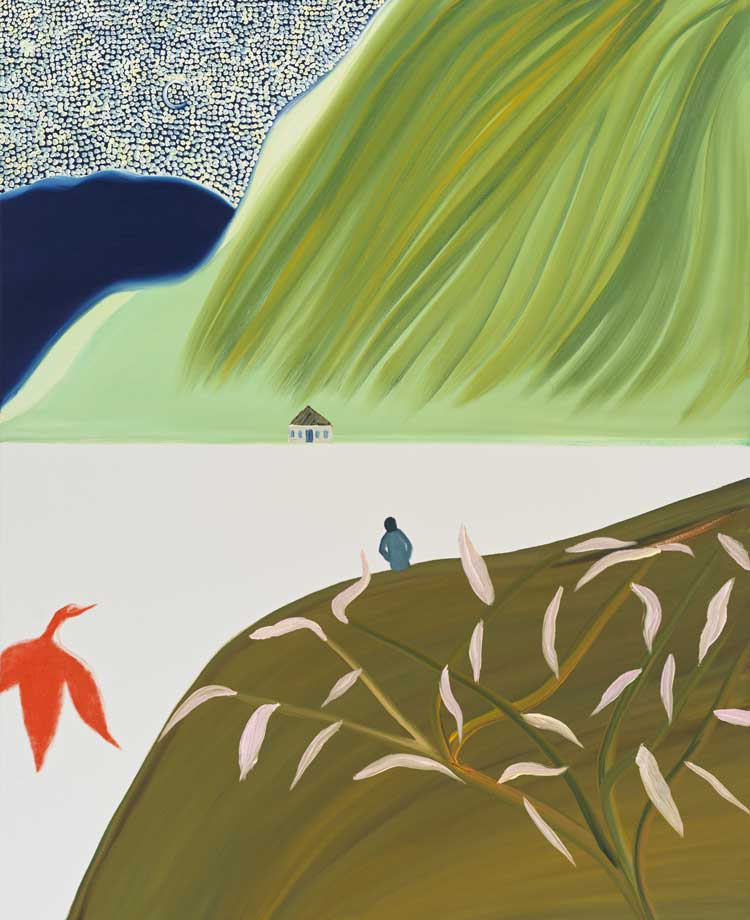
Matthew Wong, See You on the Other Side, 2019. © 2023.Matthew Wong Foundation / c/o Pictoright Amsterdam 2023.
The exhibition is one in a series that began at the Van Gogh Museum in 2022 when work by the Lebanese-American artist and poet Etel Adnan (1925-2021) was shown alongside that of Van Gogh. Director Emilie Gordenker’s aim is to show Van Gogh’s continued legacy for contemporary artists and, in so doing, to present fresh perspectives of the collection. That is certainly the case with Wong, an exhibition researched and curated by Joost van der Hoeven. Curator and director alike are clear that this is not a “compare and contrast” exhibition, something that is underlined by the fact that there are only six works by Van Gogh and more than 60 by Wong.
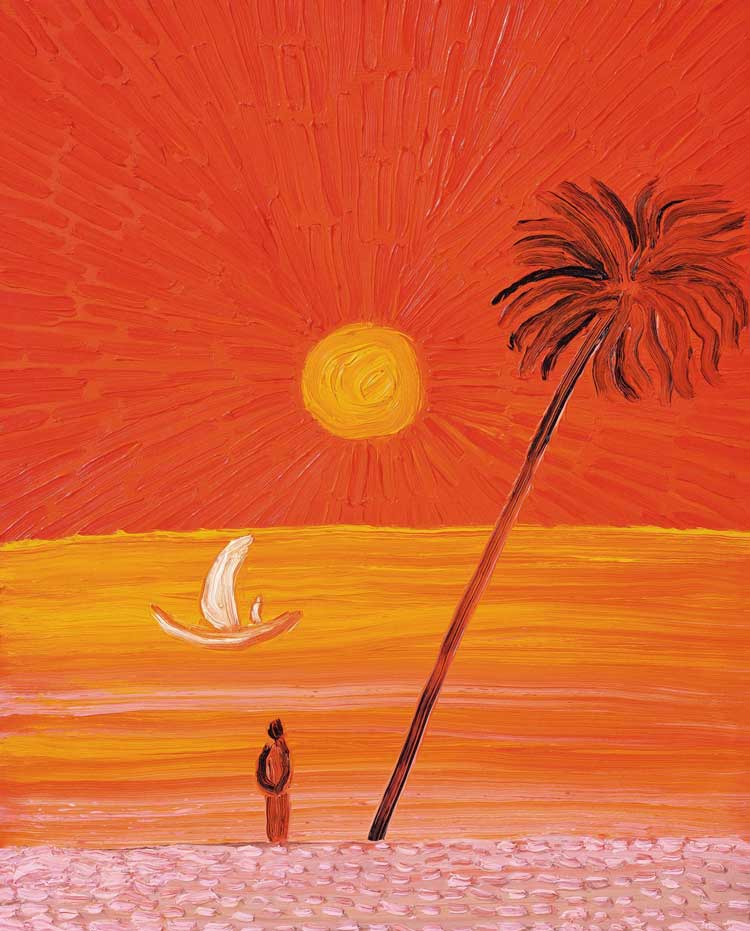
Matthew Wong, The Journey Home, 2017, Private Collection, Courtesy of HomeArt © Matthew Wong Foundation c/o Pictoright Amsterdam 2023.
Van Gogh was a major influence for Wong, but he was not the only one. Wong was a voracious reader of online texts and researched his artistic interests there. He discussed art with friends online too. In one exchange with his friend the artist Peter Shear in 2015, Wong seemed to sympathise with Van Gogh’s difficulties but admired his tenacity. Wong had tenacity, too, trying a number of different paths through life and work before settling on painting as a last resort in 2011. This was, he felt, his last chance to achieve something of success in his life. That success came quickly and by 2017 he was represented by the New York gallery Karma. In 2019, barely eight years after making his first drawing, Wong took his own life.
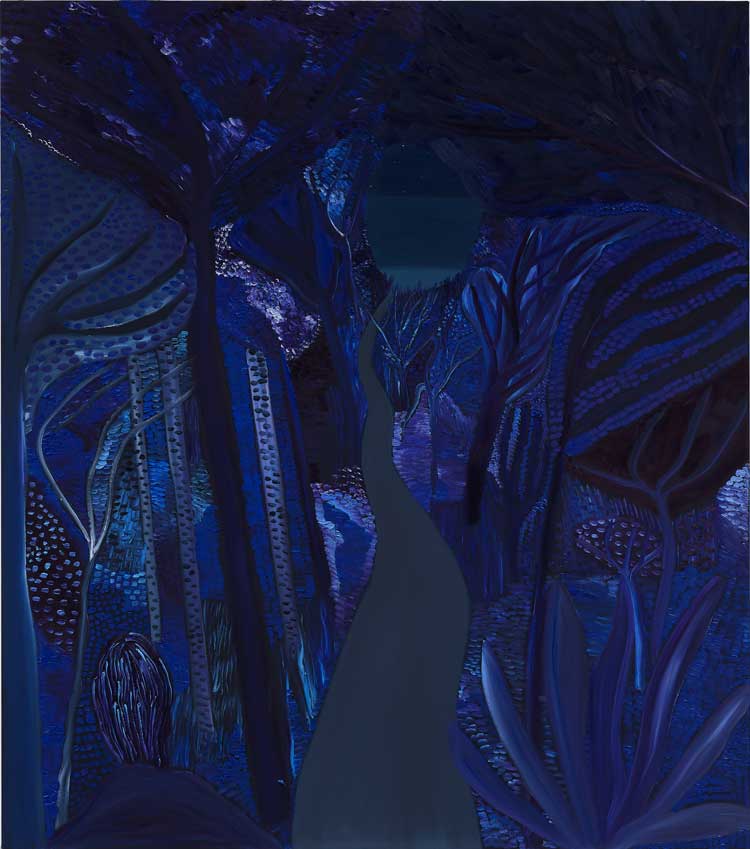
Matthew Wong, Path to the Sea, 2019. © Matthew Wong Foundation c/o Pictoright Amsterdam 2023.
This is Wong’s first retrospective in Europe and the first opportunity for his work to be shared with wider audiences. Extending over three floors of the museum’s gallery spaces, Wong’s work is exuberant and mystical. It is deeply melancholic and the intensity of colour is quite astonishing. Wong’s colours seem to come from somewhere deep inside the picture, which makes sense when you realise that he painted from inner necessity. His use of indigo, blue and violet are especially emotive, and paintings such as Blue Rain (2018), Path to the Sea (2019) and Solitude (2018) are imbued with an aching sense of deep welling loneliness. Even among the fiery crimson, gold and orange of paintings such as The Journey Home (2017) or the phenomenal The Realm of Appearances (2018), the presence of a tiny singular figure often almost hidden among the brushstrokes, Wong’s loneliness reverberates like a dampened gong, rich and resonant but diminishing in intensity as our eye repeatedly finds and loses the figure among the colour and materiality of paint laid on the canvas. As he explained it himself: “I do believe that there is an inherent loneliness or melancholy to much of contemporary life, and on a broader level I feel my work speaks to this quality in addition to being a reflection of my thoughts, fascinations and impulses.”2

Matthew Wong, The Realm of Appearances, 2018. Private Collection. © Matthew Wong Foundation c/o Pictoright Amsterdam 2023.
One crucial difference between the two artists was that Wong worked from his inner imagination while Van Gogh worked from nature. Wong educated himself in Chinese, European and American art history and, to begin with at least, embraced the traditional artistic materials of his Chinese heritage, using ink on rice paper in drawings that were resonant of American abstract expressionism. He often tried out ideas in ink before moving to paint. When it came to painting colour, Wong’s handling was intuitive, creating dreamscapes and imaginary worlds in which he and his viewers could lose themselves.
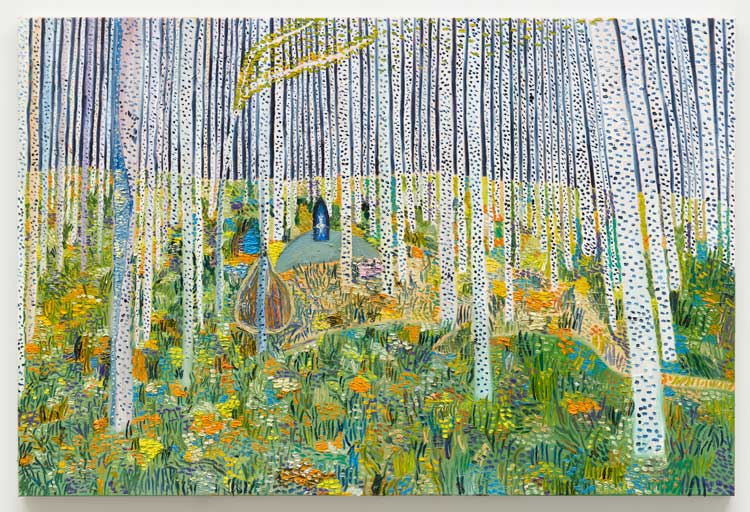
Matthew Wong, The Kingdom, 2017. Collection of Liz Lange and David Shapiro. © Matthew Wong Foundation c/o Pictoright Amsterdam 2023.
Thinking about the impact of Van Gogh and other artists in his life and work, these different strands of influence can appear individually or in multiple parts in a single painting. In a painting such as The Kingdom (2017), Wong’s multicoloured birch forest shows shades of Van Gogh, David Hockney (b1937) and Gustav Klimt (1862-1918). It also recollects the birch forests around Edmonton in Canada where Wong lived for the last three years of his life. There are echoes of other artists throughout his work too. Nostalgia (2016) may have Van Gogh at its colourful core, but The Scream (1893) by Edvard Munch (1863-1944) hangs like a deathly shadow across it. The stippled colour of Wong’s Bright Moment (2016) takes its cue from Yayoi Kusama (b1929) and his wild painterly abandon in works such as Untitled (2014) and others gestures to the likes of Willem de Kooning (1904-97) and Joan Mitchell (1925-92). Wong’s strategy with these artist and others as diverse as Henri Matisse (1869-1954), Milton Resnick (1917-2004) and Shitao (1642-1707) was to study their work intensely for a short period.
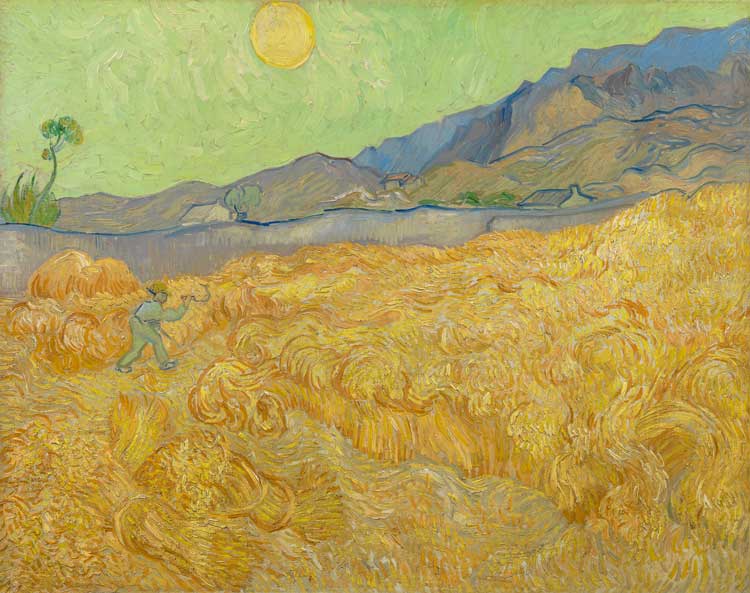
Vincent van Gogh, Wheatfield with a Reaper, 1889. Van Gogh Museum, Amsterdam (Vincent van Gogh Foundation).
His interest in Van Gogh, however, was more enduring and sustained him throughout his artistic career. Some very direct comparisons can be made, say between Van Gogh’s Wheatfield with a Reaper (1889) and Wong’s Coming of Age Landscape (2018). Yet, it is the scope and extent of Wong’s influences that really dazzles. There are more oblique refences to artists such as Adnan and Francis Bacon (1909-92), for example, and others mentioned in the exhibition texts and monograph. As someone who was such an insatiable online researcher of art and art histories, it is, of course, difficult to know where all Wong’s influences originated. The research for this exhibition rightly brings Van Gogh to the fore. It also shows how Wong used his understanding of other artists, too, to develop a unique aesthetic approach that dazzles still. For the curious visitor, a temporary display, Landscapes of Sentiment, elsewhere in the museum allows it to share some of its permanent collection and draw out other possible connections with artists such as Paul Signac (1863-1935), Charles Guilloux (1866-1946) and Odilon Redon (1840-1916).
The beautifully sensitive film that has been made to accompany Wong’s exhibition provides the perfect context for those of us unfamiliar with his work until now. A lavishly illustrated catalogue, full of in-depth essays and interviews is a wonderful publication with which to reflect further on Wong’s work too. At the very top of the exhibition, on the third floor, Wong’s wonderful painting Path to the Sea (2019) is hung in solitude and can be viewed in meditative quiet. It is an opportunity not to be missed.
References
1. Matthew Wong quoted in Van Gogh Museum press release for Matthew Wong | Vincent van Gogh: Painting as a Last Resort.
2. Matthew Wong quoted in Mathew Wong | Vincent van Gogh: Painting as a Last Resort. Edited by Joost van der Hoeven, published by Tijdsbeeld Publishing, Ghent, 2023, page 105.
• Landscapes of Sentiment is at the Van Gogh Museum, Amsterdam, until 23 June 2024.
Abstract Erotic: Louise Bourgeois, Eva Hesse, Alice Adams
A groundbreaking New York show from 1966 is brought back to life with the work of three women whose ...
Jeremy Deller – interview: ‘I’m not looking for the next thing. I...
How did he go from asking a brass band to play acid house to filming former miners re-enacting a sem...
Encounters: Giacometti x Huma Bhabha
The first of three exhibitions to position historic sculptures by Alberto Giacometti with new works ...
The Parisian scenes that Edward Burra is known for are joyful and sardonic, but his work depicting t...
The 36th Ljubljana Biennale of Graphic Arts: The Oracle
Surprising, thrilling, enchanting – under the artistic direction of Chus Martínez, the works in t...
It’s Terrible the Things I Have to Do to Be Me: On Femininity and Fame ...
In a series of essays about pairs of famous women, the cultural critic Philippa Snow explores the co...
Paul Thek: Seized by Joy. Paintings 1965-1988
A rare London show of elusive queer pioneer Paul Thek captures a quieter side of his unpredictable p...
This elegantly composed exhibition celebrates 25 years’ of awards to female artists by Anonymous W...
The first of its kind, this vast show is a stunning tour of the realism movement of the 1920s and 30...
Maggi Hambling: ‘The sea is sort of inside me now … [and] it’s as if...
Maggi Hambling’s new and highly personal installation, Time, in memory of her longtime partner, To...
Caspar Heinemann takes us on a deep, dark emotional dive with his nihilistic installation that refer...
Complex, multilayered paintings and sculptures reek of the dark histories of slavery and colonialism...
Shown in the context of the historic paintings of Dulwich Picture Gallery, Rachel Jones’s new pain...
William Mackrell – interview: ‘I have an interest in dissecting the my...
William Mackrell's work has included lighting 1,000 candles and getting two horses to pull a car. No...
Marina Tabassum – interview: ‘Architecture is my life and my lifestyle...
The award-winning Bangladeshi architect behind this year’s Serpentine Pavilion on why she has shun...
A cabinet of curiosities – inside the new V&A East Storehouse
Diller Scofidio + Renfro has turned the 2012 Olympics broadcasting centre into a sparkling repositor...
Plásmata 3: We’ve met before, haven’t we?
This nocturnal exhibition organised by the Onassis Foundation’s cultural platform transforms a pub...
Ruth Asawa: Retrospective / Wayne Thiebaud: Art Comes from Art / Walt Disn...
Three well-attended museum exhibitions in San Francisco flag a subtle shift from the current drumbea...
This dazzling exhibition on the centenary of John Singer Sargent’s death celebrates his versatile ...
Through film, sound and dance, Emma Critchley’s continuing investigative project takes audiences o...
Rijksakademie Open Studios: Nora Aurrekoetxea, AYO and Eniwaye Oluwaseyi
At the Rijksakademie’s annual Open Studios event during Amsterdam Art Week, we spoke to three arti...
AYO – interview: Rijksakademie Open Studios
AYO reflects on her upbringing and ancestry in Uganda from her current position as a resident of the...
Eniwaye Oluwaseyi – interview: Rijksakademie Open Studios
Eniwaye Oluwaseyi paints figures, including himself, friends and members of his family, within compo...
Nora Aurrekoetxea – interview: Rijksakademie Open Studios
Nora Aurrekoetxea focuses on her home in Amsterdam, disorienting domestic architecture to ask us to ...
Kiki Smith – interview: ‘Artists are always trying to reveal themselve...
Known for her tapestries, body parts and folkloric motifs, Kiki Smith talks about meaning, process, ...
Frank Auerbach, Britain’s greatest postwar painter, has a belated German homecoming, which capture...
How Painting Happens (and why it matters) – book review
Martin Gayford’s engrossing book is a goldmine of quotes, anecdotes and insights, from why Van Gog...
Jonathan Baldock – interview: ‘Weird is a word that’s often used to...
As a Noah’s ark of his non-binary stuffed toys goes on show at Jupiter Artland, Jonathan Baldock t...
Helen Chadwick: Life Pleasures
Helen Chadwick’s unwillingness to accept any binary division of the world allowed her to radically...
Catharsis: A Grief Drawn Out – book review
To what extent can the visual language of grief be translated? Janet McKenzie looks back over 20 yea...